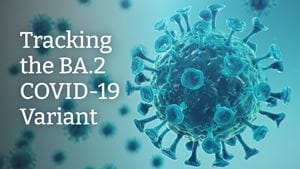
The original Omicron variant of the COVID-19 virus was discovered on November 9, 2021 and reported approximately two weeks later by the World Health Organization (WHO). However, a subvariant of Omicron is spreading rapidly throughout Western Europe and is now the dominant variant in the United States as well.
Scientists in the U.S., along with many health care systems, are closely monitoring the new subvariant – named BA.2 – to see how it behaves and the effects it could have on the general population.
Emil Lesho, DO, an infectious disease expert with Rochester Regional Health, explains what characterizes this variant and why people are focused on it now.
Since the COVID-19 pandemic began in 2020, there have been hundreds of variants of the virus. Some show up briefly with slightly different characteristics, then die off as other, more transmissible variants begin to spread more quickly.
Two of the more wide-spread COVID-19 variants over the last two years were the Delta and Omicron variants. The original Omicron variant has a “large number of mutations”, according to the WHO. These mutations allow the virus to be more transmissible than previous variants, more resistant to some monoclonal antibody treatments, and able to infect those who received their full dosage of COVID-19 vaccines – including booster doses.
The organization designated Omicron as a variant of concern due to those mutations. Because BA.2 is a subvariant of Omicron, it is also a variant of concern.
“We are very likely to begin seeing cases of the BA.2 variant in our area, because it now accounts for 30 percent of new infections in New York City,” Dr. Lesho said in late March. “It is unclear whether it causes more severe symptoms in patients, but it spreads more quickly compared to other variants.”
Based on what providers are reporting in current healthcare settings in the U.S., symptoms appear to be similar to other COVID-19 cases. The symptoms typically seen in a COVID-19 diagnosis are:
“So far, it looks like the BA.2 subvariant is about twice as contagious as the original Omicron, but it does not appear to be more severe,” Dr. Lesho said.
One of the reasons why people are focused on the BA.2 variant is the rising number of cases linked to the variant in other countries.
Data from the WHO shows cases have been rising over the last two weeks in the United Kingdom, Denmark, Germany, India, and Sweden.
There are a number of factors that will determine if the U.S. will see an uptick in the number of cases, hospitalizations, and/or deaths linked to the BA.2 variant. Some of those include:
According to CDC data, the BA.2 variant accounts for more than 50 percent of all COVID-19 cases in the U.S. as of late March.
“There are many factors that could affect not only the number of COVID-19 cases, but also the number of hospitalizations and deaths we see due to this emerging BA.2 variant,” Dr. Lesho said. “We want to ensure we are monitoring this variant as closely as possible so we can identify the best ways to protect everyone in our community – especially the most vulnerable.”
The ways individuals can appropriately protect their health remain the same as they have throughout most of the pandemic.
A recent study published in the New England Journal of Medicine found vaccinated individuals who were infected with the Omicron variant had high levels of immunity against becoming infected again.
“There are many ways of protecting yourself against the COVID-19 virus, but getting the COVID-19 vaccine and a booster dose if you are eligible is the most effective way to do so,” Dr. Lesho said. “Research continues to show vaccinated and boosted individuals are significantly less likely to have severe illness, become hospitalized, or die from COVID-19 compared to unvaccinated individuals.”